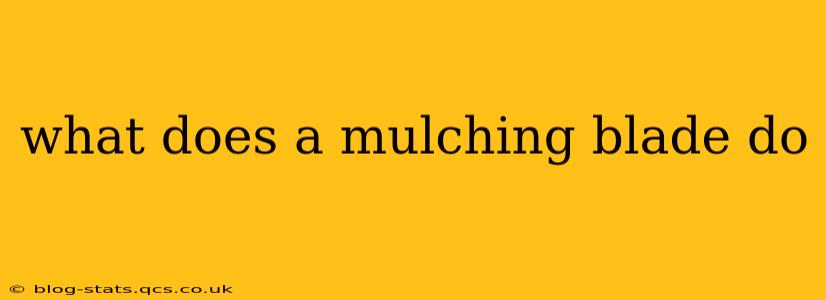A mulching blade is a specialized lawn mower blade designed to finely chop grass clippings into tiny pieces, returning them to the lawn as natural fertilizer. Unlike standard blades that discharge or bag clippings, a mulching blade's unique design significantly enhances lawn health and reduces the need for chemical fertilizers. This article will explore the mechanics of a mulching blade, its benefits, and answer common questions surrounding its use.
How Does a Mulching Blade Work?
The key to a mulching blade's effectiveness lies in its design. Instead of simply cutting the grass, it employs a series of curved, sharp edges and strategically placed baffles. These features create a powerful cutting and recirculation system within the mower deck. The grass is repeatedly chopped and shredded as it's thrown around inside the deck, ultimately resulting in tiny grass particles that are too small to be easily noticeable. These tiny particles then decompose quickly, returning essential nutrients to the soil.
What are the Benefits of Using a Mulching Blade?
The benefits of using a mulching blade extend beyond simply eliminating the need to bag or dispose of grass clippings. Here are some key advantages:
-
Natural Fertilizer: Grass clippings are a rich source of nitrogen and other nutrients. Returning these nutrients to the soil through mulching provides a natural, cost-effective way to fertilize your lawn, reducing or eliminating the need for chemical fertilizers.
-
Improved Soil Health: The finely chopped grass clippings decompose quickly, improving soil structure, water retention, and aeration. This creates a healthier environment for grass roots to thrive.
-
Reduced Lawn Waste: By recycling grass clippings, you eliminate the need to bag and dispose of them, reducing landfill waste and saving you time and effort.
-
Thicker, Healthier Lawn: The constant supply of nutrients from mulched grass leads to a thicker, greener, and more resilient lawn, better able to withstand drought and disease.
-
Saves Time and Money: No more bagging, emptying, or disposing of grass clippings! This saves you valuable time and reduces the cost associated with purchasing and using chemical fertilizers.
What Types of Mulching Blades are Available?
There are various types of mulching blades available, designed to suit different mower types and lawn conditions. Some blades feature more aggressive cutting teeth for thicker, tougher grasses, while others are designed for finer mulching on delicate turf. It's important to choose a blade that is compatible with your mower model.
Can I Use a Mulching Blade on Any Mower?
Not all lawn mowers are designed for mulching. While many mowers can be adapted for mulching with the correct blade, some models require additional modifications, such as a mulching kit, to effectively recirculate the grass clippings. Check your mower's manual to determine if it's compatible with mulching blades.
How Often Should I Sharpen My Mulching Blade?
A sharp mulching blade is crucial for effective mulching. Dull blades will tear the grass instead of cutting it, resulting in larger, less desirable clippings that can mat down and smother your lawn. Sharpen your blade at least once or twice per season, or more often if necessary, depending on usage.
Does Mulching Work on All Types of Grass?
While mulching is generally beneficial for most grass types, the effectiveness can vary. For example, tall fescue and other thick grasses may require more frequent mowing to prevent thatching, even when using a mulching blade. Experimentation and adjusting mowing height might be necessary to find the optimal settings for your specific grass type.
What are the Disadvantages of Mulching?
While the benefits outweigh the disadvantages for many homeowners, it's important to note that mulching might not be suitable for everyone. Potential downsides include:
-
Thatching: If you mow too infrequently or have excessively thick grass, mulching can lead to thatch buildup. Regularly mowing to the correct height and aerating the lawn can mitigate this risk.
-
Disease Risk (rare): In rare instances, excessively damp conditions combined with dense thatch can increase the risk of fungal diseases. Proper lawn care practices such as aeration and proper fertilization generally prevent this.
By understanding the mechanics and benefits of a mulching blade, you can make an informed decision about whether this approach to lawn care is right for you and your lawn. Remember to always consult your mower's manual for specific instructions and compatibility information.
